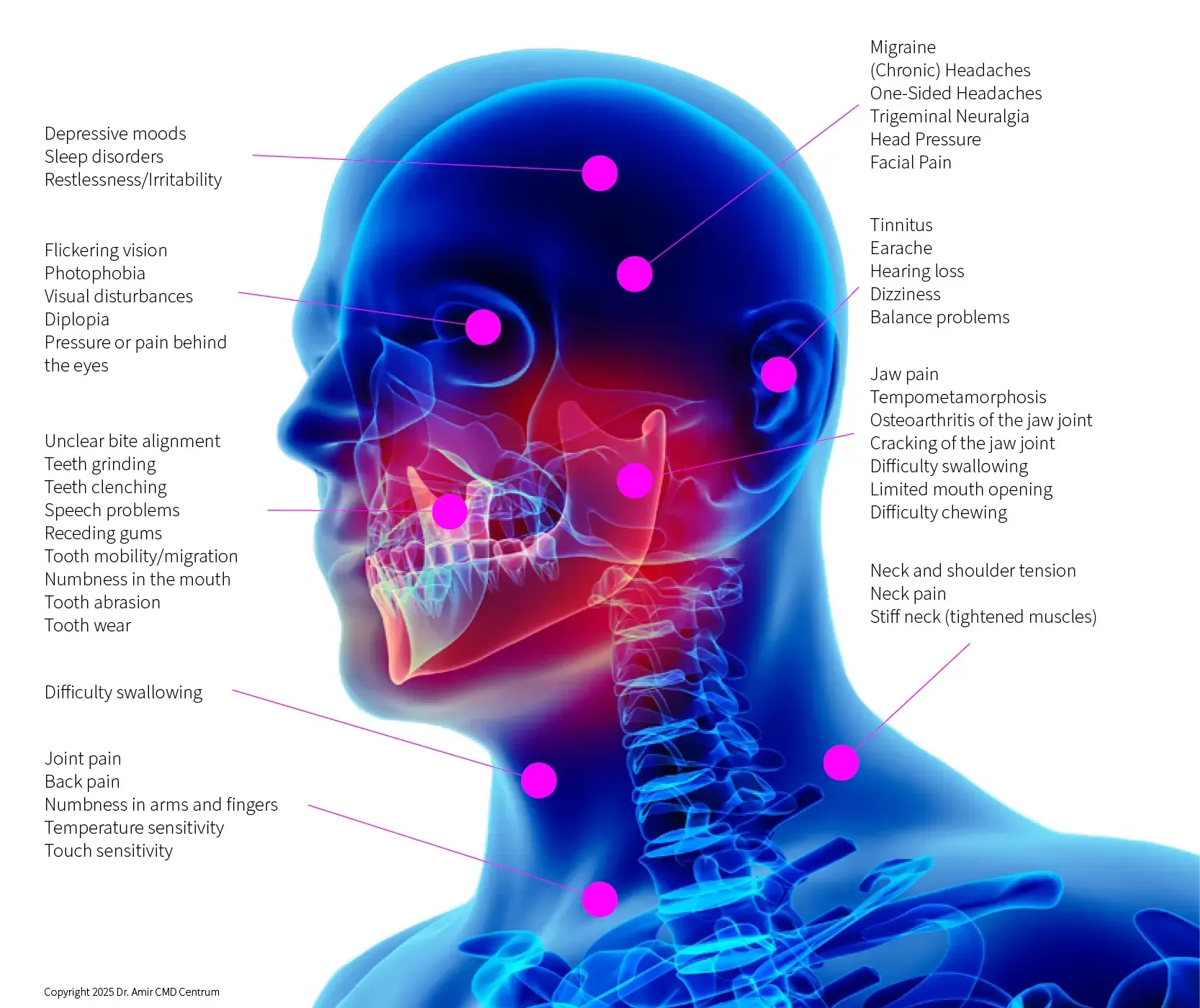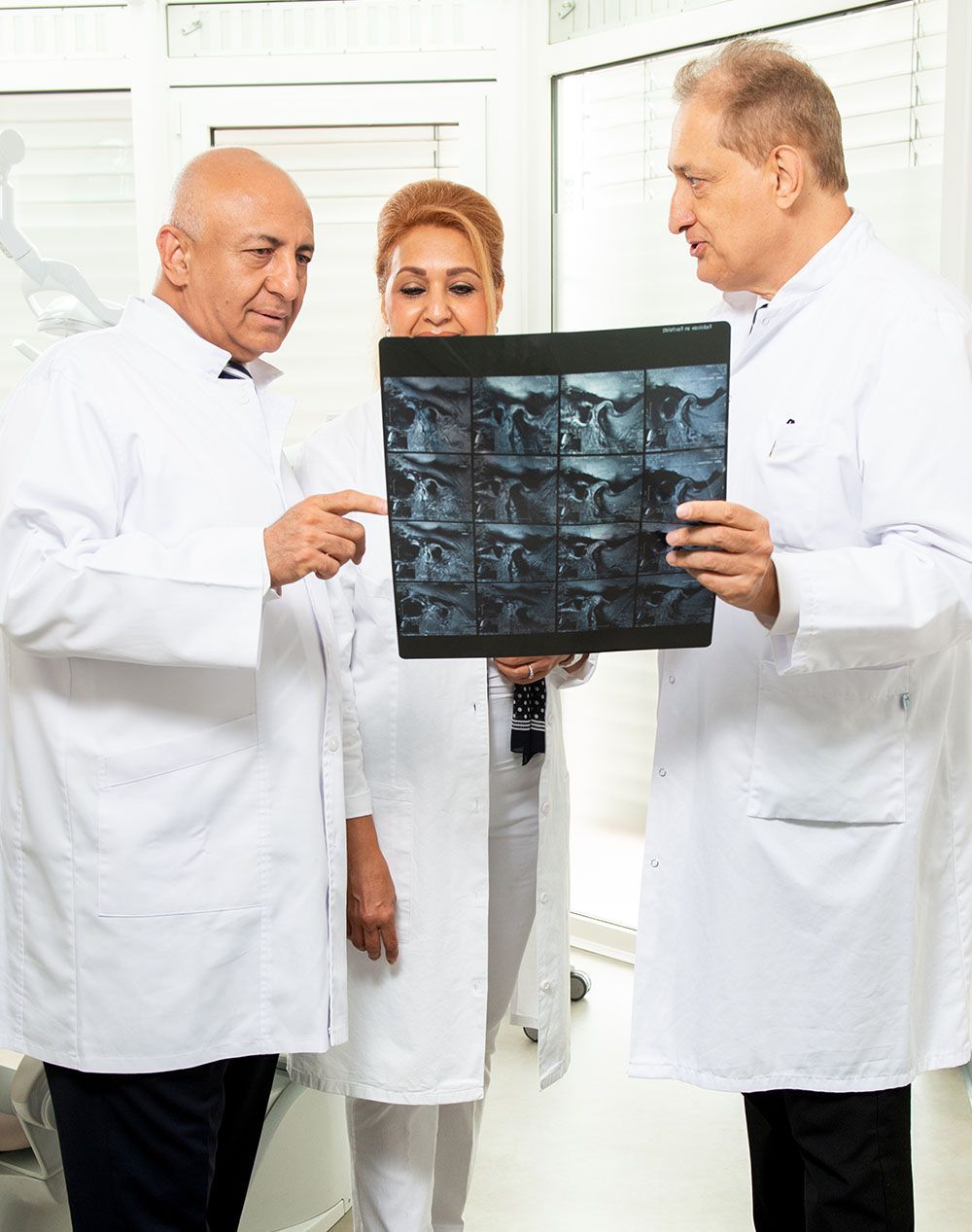Information about the
Temporomandibular joint disorder (TMJ disorder)
Perhaps you've heard of this term yourself or perhaps you're suffering from jaw pain that no one can quite explain. Below, we'd like to give you an overview of what The TMJ disorder actually is, its causes and symptoms and how we treat it.
What is TMJ disorder?
The temporomandibular joint disorder (TMJ disorder) is an umbrella term for a range of conditions and dysfunctions affecting the masticatory system. This system is complex and includes:
The temporomandibular joints
The joints that connect the lower jaw (mandible) to the skull (cranium)
The masticatory muscles
The muscles responsible for chewing and other jaw movements
The teeth
Their position and occlusion play an important role
Associated structures
Nerves and ligaments in the head and neck region
At its core, the TMJ disorder is a malfunction or disturbed interaction within this system. This means that normal processes such as biting, chewing, speaking or even yawning no longer function harmoniously and painlessly.
Typical aspects of a TMJ disorder include:
- Pain: This can occur in the jaw joints themselves, in the chewing muscles, in the face, in the teeth, or radiate to the head, neck, shoulders, and, less frequently, the back.
- Limited jaw function: Difficulty opening the mouth (jaw lock), inability to close the mouth (lockjaw), or limited lateral mobility of the lower jaw.
- Jaw noises: Cracking, rubbing, or grinding in the jaw joints during movement.
- Muscle tension: Hardening and tender points in the chewing, facial, neck, and shoulder muscles.
- Dental problems: Unexplained toothache, wear and tear on the teeth due to grinding (bruxism), or the feeling that the teeth no longer fit together properly.
- Various accompanying symptoms: The TMJ disorder can also be associated with headaches (often tension headaches or migraines), dizziness, tinnitus (ringing in the ears), sleep disturbances, or even visual disturbances.
TMJ disorder symptoms
A TMJ disorder can manifest in different ways. Typical symptoms include:
Jaw joint pain or jaw joint noises
· Cracking, crunching or rubbing when chewing or speaking
Pain in the chewing muscles
· Pulling or pressing pain
Restrictions on opening the mouth
· Difficult or painful opening of the mouth, sometimes also jaw locking
Teeth grinding/clenching (bruxism)
· Often at night, but also during the day in stressful situations
Radiating pain
· Head, neck, shoulder or back pain that can be caused by TMJ disorder
Dizziness or ringing in the ears
· In some cases, jaw dysfunction can affect the balance organ
TMJ disorder causes
A TMJ disorder usually has more than one single cause. Often, it's a combination of several factors:
Tooth and jaw misalignment
· Slanted bite (e.g. overbite, crossbite, open bite)
· Inappropriate crowns, bridges or fillings
Muscular causes
· Overloading of the chewing muscles due to teeth grinding/clenching (bruxism)
· Tension in the neck and shoulder area that is transferred to the jaw
Stress and psychological strain
· Frequent teeth grinding in stressful situations (unconsciously during the day or while sleeping)
Poor posture
· Problems of the cervical and thoracic spine can affect the jaw
Injuries
· Accidents or blows to the jaw that impair joint function
Tumor
· In very rare cases, a tumor in the area of the temporomandibular joint or the surrounding structures can also be the trigger. Such a tumor can lead to pain, restricted movement or jaw noises due to pressure on nerves, muscles or the joint itself.
TMJ disorder diagnosis
If Temporomandibular joint disorder is suspected, a thorough examination should be carried out by our specialists.
Conversation and anamnesis
· Questions about your complaints, lifestyle habits and possible stress
Manual examination of the jaw
· Opening and closing movements of the mouth
· Palpating the chewing muscles and the jaw joint for pain or tension
Analysis of the Bisses
· Examination of the tooth position and comparison of the upper and lower teeth
Imaging (only if necessary)
· X-rays, MRI (magnetic resonance imaging) or CT (computed tomography) can help to accurately assess the temporomandibular joints
Further possible investigations
· Consultation and therapy in neurology
· If necessary, additional clarification by orthopaedists, ENT specialists or physiotherapists
TMJ disorder TherapY
The treatment of a TMJ disorder should always be interdisciplinary. This means that different specialisms work together to ensure that your symptoms are actually alleviated in the long term.
Dental therapy
· Fitting high-quality functional splints for relief and therapy of the temporomandibular joints
· In rare cases, correction of tooth or bite misalignments through orthodontic and/or prosthetic measures
Physiotherapy
· Special exercises to loosen and relax the chewing muscles
· Heat treatments, massages, stretching exercises in the jaw area as part of manual therapy
Electrical stimulation
· Muscle relaxation and pain relief through transcutaneous (Latin for "through the skin") electrical nerve stimulation (TENS)
· Therapy with the TENS device specially tailored to the symptoms of CMD is carried out in our practice
Drug treatment
· Pain medication for acute complaints
· Muscle relaxants in special cases
· Taking magnesium
When should you go to the dentist?
- If you regularly experience pain in your jaw or face.
- For frequent or loud jaw clicking (with or without pain) and sudden jaw clicking.
- If mouth opening is restricted, so that eating or speaking is impaired
- If you or those around you (e.g. partner) notice teeth grinding or clenching
- Whe.never you are unsure or new symptoms occur.
TMJ disorder
self-test
Recognize the signs!
Please note that this test is intended only as a guide. Only a dentist or specialist can provide an accurate diagnosis and an individualized treatment plan.




